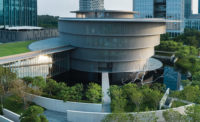Naoshima, Japan
A building within a building, the Ando Museum celebrates work on the Inland Sea island of Naoshima by one of Japan’s most influential architects. Designed by Tadao Ando himself, it looks like a 100-year-old wooden house from the outside. But within this modest residential exterior, Ando placed a contrasting interior defined by concrete and articulated by daylight–the pillars of his architecture. Commissioned by the Naoshima Fukutake Art Museum Foundation, the new museum is the Osaka designer’s ninth project on Naoshima.
A former industrial outpost, the island was reborn 25 years ago under the aegis of Soichiro Fukutake, whose father founded the successful Fukutake Publishing Company. “Mr. Fukutake wanted to create an island where artists wanted to place their art,” explains Tadao Ando. Fukutake managed to do so partly with the aid of Ando, who authored the combined art museum-hotel Benesse House, Naoshima’s first major development, as well as the more recent Chichu (RECORD, October 2005, page 116) and Lee Ufan museums, among other buildings on the island. But when it came to displaying the architect’s own work, Fukutake asked Ando to utilize the historic house, one of many purchased by Fukutake for art installations. While a number of Naoshima’s 430,000 annual visitors come to see its contemporary art collection, few leave unmoved by Ando’s architecture.
Located in the town of Honmura, the Ando Museum sits amid a tight cluster of historic dwellings, most still inhabited by island residents. The building faces a narrow street with a gravel-covered courtyard that leads into the museum. The only hint of anything extraordinary is a small glass cone embedded in the pebbly ground. While Ando retained the shell of the original two-story home, he gutted the interior and extended the structure into the back garden. Enclosed by a tile roof and walls of blackened yaki-sugi (the traditional charred cedar planks favored on Naoshima), the new construction melds effortlessly with the old.
Inside, the structure shifts from antique to contemporary, wood to concrete, and familiar to otherworldly. The entrance hall, primarily made with tsuchikabe (rammed-earth) walls and a stone-studded araidashi floor, recalls the original foyer. From there, stairs ascend to the exhibit area, where models and photos of Ando’s Naoshima works are on display. Delineated by freestanding walls and floor-level changes, the room is sliced into three distinct galleries layered front to back: a double-height oblong outlined by wood columns and beams, a narrow wedge sandwiched between concrete partitions (but open to the pitched roof), and a rectangle with a concrete rear wall that morphs into a vaulted ceiling. Adjacent stairs descend to an underground meditation chamber. Hiding this new construction in and under the existing building preserved the island’s charm through what Ando calls “invisible architecture.”
Free of the organization and expression of the old house, the cryptlike chamber is entombed in a slanted concrete cylinder measuring 9 feet in diameter. Capping the space, a floating ceiling ringed with muted daylight emits an eerie glow. The light source, a conical skylight in the courtyard, is the earth-embedded room’s only connection to the outside world. Together, the semi-darkness, round shape, and tilted axis generate an illusory sensation of unsteadiness, as if the floor were off-kilter. “When a building cannot be seen, the quality of its space becomes the only matter of importance,” remarks Ando.
Creating the subterranean cylinder was the first stage of construction. In preparation, the contractors dismantled the existing house and stored its reusable parts. Then they excavated a portion of the courtyard, poured a concrete tube and, once it cured, surrounded it with earth. Next, the crew built the above-grade galleries—a contiguous concrete mass—finally covering them with the reconstituted wood house.
Wherever possible, Ando used the salvaged beams, columns, and roof tiles, reassembling them using traditional techniques. Elsewhere, he replaced worn-out parts with exacting facsimiles. The greater challenge, however, was crafting the concrete formwork needed for the new walls’ silky texture and geometric complexity. Though smaller than Ando’s other Naoshima museums, this building incorporates some of his most sophisticated shapes to date. While fabricating the wood molds required advanced computer imaging and precision craftsmanship, the concrete’s natural finish came from the formworks’ carefully treated inner surfaces, which had to be damage-free and smooth. Even stray flecks of dust would compromise the results.
This meticulous attention to detail yielded untreated concrete so glossy that it reflects enough daylight to gently illuminate the galleries. While relying exclusively on the sun restricts the museum’s operating hours, it also eliminated the need for electrical fixtures (except at the ticket desk and in the stair landing). Instead, a long skylight, parallel to the roof’s ridge beam, and carefully placed wall slits are the main sources of light. Filtering down from above, the sun’s rays ricochet off the angled wall in the middle of the gallery, illuminating the whole room and altering the perception of the space throughout the day.
While soft light might seem counterintuitive in a museum, it evokes the demure beauty of a shadowy corner or a dim room, common sights in traditional Japanese houses. Plus the exhibits are not the museum’s raison d’être. “Before, I wanted to make spaces suited for art,” explains the architect. “But this museum makes a statement just through its architecture.” In the process, Ando retains the memory of the old house while invigorating it with a new identity—an apt metaphor for Naoshima itself.
People
Client:
Architect:
General Contractor:
Structural Engineer:
Mechanical / Electrical engineer : Size: 2,051 square feet (site area); 1,233 square feet (building area); 1,355 square feet (floor area) Cost: withheld Completion date: March 2013 |
Products
Structure:
Finish: Exterior floor: Gravel
Interior floor: Interior wall: Exposed concrete plaster Ceiling: exposed concrete exposed timber structure roof frame |











.jpg?height=200&t=1692184429&width=200)
